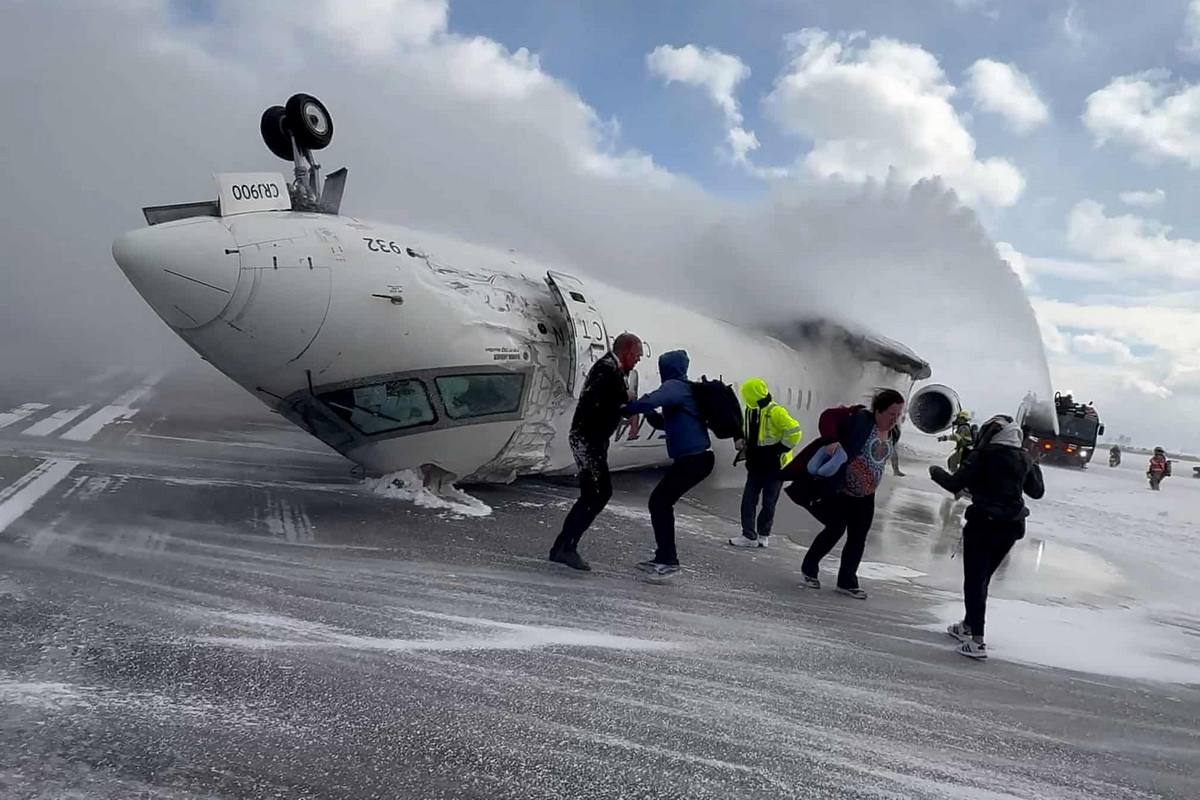On a fateful day in Toronto, a dramatic incident involving a Delta Airlines flight shocked passengers, onlookers, and aviation experts alike. This tragic event left many questioning how such a situation could unfold. The story of the Delta plane flipping over at Toronto Pearson International Airport is both haunting and enlightening, shedding light on the challenges faced by modern air travel and safety measures.
What Happened?
The disaster began when Delta Flight 3053, a Boeing 737-900, was attempting to land at Toronto Pearson International Airport. Conditions were not unusual—visibility was decent, and the airport's state-of-the-art landing systems were functioning. However, something went terribly wrong during the final moments of landing.
As the plane descended and touched the runway, an unexpected sequence of events took place. The aircraft veered sharply off the landing strip, causing the wheels to lose traction and the plane to lose control. Within seconds, the plane flipped over, skidding along the tarmac before coming to a stop. Fortunately, the airport's swift response, alongside quick-thinking emergency personnel, ensured that no passengers were seriously harmed, though the incident was alarming on many levels.
Key Factors Leading to the Incident
Several factors may have contributed to the tragic event. While investigations are ongoing, early reports indicate a combination of mechanical failure, human error, and unexpected weather conditions as potential causes.
- Weather Conditions:
- Rain and wind may have played a role in reducing traction on the runway, making it difficult for the plane to land smoothly.
- Sudden gusts of wind during the final moments of landing may have disrupted the aircraft’s control, leading to the plane skidding off track.
- Aircraft Malfunction:
- Preliminary analysis suggests that a potential malfunction in the landing gear or braking system could have resulted in the loss of control after touchdown.
- The aircraft’s engines may not have been able to reverse thrust as intended, exacerbating the skidding and causing it to flip.
- Human Error:
- Though the crew is highly trained, human error cannot be ruled out. Possible misjudgments during the final stages of landing, coupled with mechanical complications, may have combined to cause the aircraft to veer off course.
Passenger Experiences: A Terrifying Moment
For the passengers aboard Delta Flight 3053, the moment was one of sheer terror. Passengers recounted their experiences, many describing the sudden loss of control as terrifying.
- Panic and Chaos:
- Passengers reported a loud, unsettling noise followed by the sensation of the plane shaking violently.
- Several were thrown from their seats as the plane flipped, while others held onto whatever they could for stability.
- Emergency Responses:
- As soon as the plane came to a halt, emergency slides were deployed, and flight attendants swiftly guided passengers to exit the plane.
- Despite the confusion and fear, there were no reports of serious injuries, thanks in large part to the quick emergency response.
What Has Been Done to Prevent Future Accidents?
In the wake of this event, both Delta Airlines and aviation authorities have taken swift actions to investigate the causes and prevent similar accidents in the future.

- Increased Safety Protocols:
- Safety protocols have been revised and reinforced to ensure that planes can handle unexpected weather conditions more effectively.
- More advanced training is being introduced to help flight crews better react to extreme circumstances, such as unexpected loss of control after landing.
- Aircraft Technology Overhaul:
- Delta Airlines is investing heavily in upgrading its fleet with more reliable braking systems, stronger landing gears, and improved sensors to assist pilots during critical landing moments.
- New AI-driven systems are being developed to predict hazardous conditions on runways and provide real-time data to pilots.
- Collaboration with Airport Authorities:
- Toronto Pearson International Airport is working closely with aviation experts to upgrade runway systems and enhance the grip during wet weather conditions.
- A review of emergency protocols has been conducted to ensure that the airport is fully prepared for any unforeseen disasters.
Public Reaction: Questions on Air Safety
The Delta plane flip over in Toronto prompted widespread discussions about air safety, particularly concerning the complexity of modern air travel. Although the situation ended without fatalities, it raised significant questions about the state of aviation safety and the need for continued vigilance.
- Public Outcry for Improved Safety Measures:
- Many individuals took to social media, demanding that airlines and airports invest more in preventing these kinds of accidents. Passengers are seeking transparency in the investigation and an explanation of how such a situation could arise.
- Concerns Over Airline Accountability:
- Some critics argue that airlines must be more accountable when accidents occur, calling for stricter regulations and more robust safety standards.
Conclusion: A Close Call
Though the Delta plane flip over in Toronto remains an unsettling event in the history of aviation, it serves as a stark reminder of the complexities of air travel. With the advancement of technology and better safety measures, the chances of such an incident happening again are significantly reduced. However, it also emphasizes the importance of continued vigilance, innovation, and training within the aviation industry to ensure that safety remains the number one priority.
As investigations continue, passengers and industry experts alike are hopeful that valuable lessons will be learned from this event, leading to safer skies for all.
